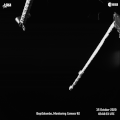File:BepiColombo points to Venus ESA22264108.gif
From Wikimedia Commons, the free media repository
Jump to navigation
Jump to search

Size of this preview: 600 × 600 pixels. Other resolutions: 240 × 240 pixels | 480 × 480 pixels | 819 × 819 pixels.
Original file (819 × 819 pixels, file size: 8.75 MB, MIME type: image/gif, looped, 64 frames, 13 s)
File information
Structured data
Captions
Captions
Add a one-line explanation of what this file represents
Summary
[edit]| DescriptionBepiColombo points to Venus ESA22264108.gif |
English: A sequence of images taken by one of the monitoring cameras on board the European-Japanese BepiColombo mission to Mercury, as the spacecraft slewed to point towards Venus ahead of its 15 October flyby. This sequence of 64 images was captured by the Monitoring Camera 3 onboard the Mercury Transfer Module between 06:58 UTC and 13:57 UTC on 14 October 2020, corresponding to a distance of approximately 600 000 km to 400 000 km from Venus. One image was taken approximately every three minutes. At first, Venus is seen clearly moving across the field of view close to the spacecraft body on the left, because the spacecraft is slewing to point to Venus. Then, Venus gets progressively bigger in the field of view, as the spacecraft approaches. The shadow moving across the spacecraft is cast by the Mercury Transfer Module solar array. The camera provides black-and-white snapshots in 1024 x 1024 pixel resolution. The images have been lightly processed to enhance the brightness and contrast. The gravity assist manoeuvre was the first at Venus and the second of nine flybys overall, which help steer the spacecraft on course for Mercury. During its seven-year cruise to the smallest and innermost planet of the Solar System, BepiColombo makes one flyby at Earth, two at Venus and six at Mercury to brake against the gravitational pull of the Sun in order to enter orbit around Mercury. BepiColombo, which comprises ESA’s Mercury Planetary Orbiter and the Mercury Magnetospheric Orbiter of the Japan Aerospace Exploration Agency (JAXA), is scheduled to reach its target orbit around the smallest and innermost planet of the Solar System in 2025. |
| Date | 15 October 2020 (upload date) |
| Source | BepiColombo points to Venus |
| Author | ESA/BepiColombo/MTM |
| Other versions |
|
| Activity InfoField | Space Science |
| Mission InfoField | BepiColombo |
Licensing
[edit]This media was created by the European Space Agency (ESA).
Where expressly so stated, images or videos are covered by the Creative Commons Attribution-ShareAlike 3.0 IGO (CC BY-SA 3.0 IGO) licence, ESA being an Intergovernmental Organisation (IGO), as defined by the CC BY-SA 3.0 IGO licence. The user is allowed under the terms and conditions of the CC BY-SA 3.0 IGO license to Reproduce, Distribute and Publicly Perform the ESA images and videos released under CC BY-SA 3.0 IGO licence and the Adaptations thereof, without further explicit permission being necessary, for as long as the user complies with the conditions and restrictions set forth in the CC BY-SA 3.0 IGO licence, these including that:
See the ESA Creative Commons copyright notice for complete information, and this article for additional details.
|
 | |
This file is licensed under the Creative Commons Attribution-ShareAlike 3.0 IGO license. Attribution: ESA/BepiColombo/MTM, CC BY-SA IGO 3.0
| ||
File history
Click on a date/time to view the file as it appeared at that time.
| Date/Time | Thumbnail | Dimensions | User | Comment | |
|---|---|---|---|---|---|
| current | 15:46, 15 October 2020 |  | 819 × 819 (8.75 MB) | OptimusPrimeBot (talk | contribs) | #Spacemedia - Upload of https://www.esa.int/var/esa/storage/images/esa_multimedia/images/2020/10/bepicolombo_points_to_venus/22264097-4-eng-GB/BepiColombo_points_to_Venus.gif via Commons:Spacemedia |
You cannot overwrite this file.
File usage on Commons
There are no pages that use this file.
Metadata
This file contains additional information such as Exif metadata which may have been added by the digital camera, scanner, or software program used to create or digitize it. If the file has been modified from its original state, some details such as the timestamp may not fully reflect those of the original file. The timestamp is only as accurate as the clock in the camera, and it may be completely wrong.
| Unique ID of original document | 9E77707288210E152AA33A1C301B70B8 |
|---|---|
| Software used | Adobe Photoshop Lightroom Classic 9.4 (Macintosh) |


